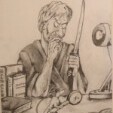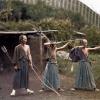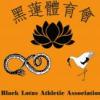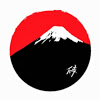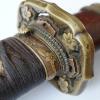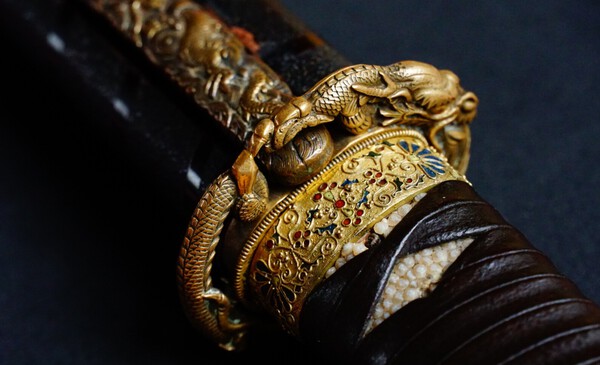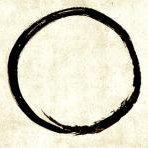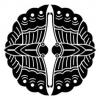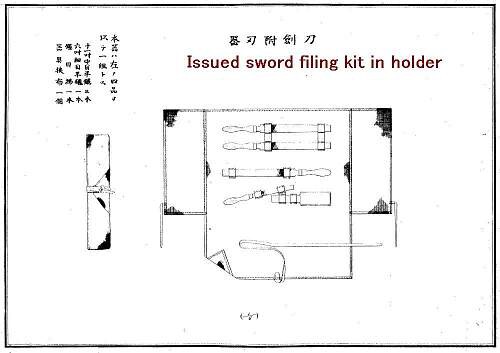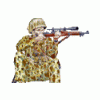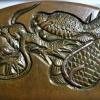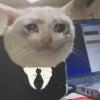Leaderboard
Popular Content
Showing content with the highest reputation on 07/21/2021 in all areas
-
Funnily enough Geraint I had just that experience a couple of days ago. A friend from over the border was able to visit for the first time in more than a year and we had a great afternoon looking at blades and discussing what we saw. Sad to say he forgot one when he left so I now have the opportunity to study a beautiful ko-wakizashi for an extra couple of weeks. It was great to have that opportunity. I find I am increasingly caught between the devil and deep blue sea. I understand Kirill's comment (I think) On various platforms focus on papers is largely used as a substitute and shortcut to study. However the counter that are those with their own agenda damning the attribution systems. We send a very confusing message to anyone starting out in this field. Sorry I don't want to divert the thread I was just motivated by Geraint's comments about meetings. Sitting with friends studying swords in hand is definitely the best way to go8 points
-
Well we are in the middle of a heat wave, (for the UK that means the drizzle is slightly warm) so even the prospect of a coat is un bearable. Don't even think about getting yours John! Kirill's comment, like so many aphorisms, has a great deal of truth in it but we work with what we have got and on a forum that means we are largely at the mercy of photographs and papers. In this case we have an out of polish sword with a mei and we are not even agreed on what the mei says yet. Sometimes we can help along the way but definitive answers are hard to come by and usually the best results are from some of the swords which have gone on to polish and shinsa. From time to time a friend will turn up with a sword or two and we look at them together, one spots something the other had not picked up on and vice versa, we throw around some ideas and in the process learn a little from each other, it's not high level kantei but it's fun. That's pretty much what is going on here though some are able to offer more informed opinions, generally we are tolerant of each other and if someone throws out an idea somebody else is on hand to counter and in the process, hopefully everyone learns a little more. In spit of the heat wave maybe I'd better get my coat now. All the best.6 points
-
KABOKU. George Trotter's comment above in 2015, prompted me to put a few pics up of the sword that he commented won the 2011 Sydney Shinsa. I am "the lucky owner" as George describes. The sword is as interesting as is the historical story above, documenting on the killing of his assassin with a severed hand. This sword is in wonderful polish, and any marks seen in the photos are due to cleaning the oil off.6 points
-
With the restrictions imposed on society, it now seems an eternity that I have managed to attend an arms fair, having to make do with on-line auctions as a means of acquiring the odd item. Earlier this year I was attracted by a sword listed by an auction house here in the UK. The description and photographs were not particularly encouraging except for one photo of an oxidised silver kojiri of the leaves and seed head of rice that writhed in relief around the black lacquered scabbard. Hovering above this were sparrows in gold and coloured lacquer. Another rather out of focus image taken of the hilt and tsuba, viewed from the kashira end of the tsuka showed the latter was missing and that the tsuba was textured in some way. To cut a long story short, I bid against another and won the auction, paying rather more than I had anticipated, but in retrospect an acceptable amount. On collecting the sword from the auction house, I realised I had acquired what is probably the finest sword it has been my good fortune to own. I won't go into the details of the blade here, that turned out to be potentially one heck of a bonus, concentrating on the fuchi and tsuba. As the title of this post indicates, it turned out that the 'texture' I had seen in the initial photographs was caused by the wires and partial enamel fill of the cloisonne decoration. I have never pretended to know anything about sword fittings, but I did know that the Hirata specialised in this technique and generally did small badge-like motifs in cloisonne that were then attached to tsuba and other fittings. In this case however, the whole surface of the tsuba and fuchi have been gilded and covered with the raised wires, enamel being confined to only a few places and only becoming obvious when examined closely. I've never seen anything like these and I wonder if it was more common.3 points
-
Need a better shot of the nakago to properly read it, but my guess is 濃州関住服部正廣作 (Nōshū Seki jū Hattori Masahiro saku). That sword in those fittings should be worth north of $2000.3 points
-
A friend of mine with an extensive collection of militaria, much of it WWI and WWII, has passed away. I agreed to help the family identify and find homes for his collection, that they didn't even know existed. For years I've been helping him sell sabers, bayonets, uniforms, etc. I have photos of several swords that vary from wartime stampings to a handful that are more interesting, though I doubt any are significantly valuable. I'll post one at a time so there's time for clear discussion. I also have two for the main forum, as those do appear to be traditional, though recent.2 points
-
2 points
-
2 points
-
I'd like to keep it. But my budget is not unlimited, and my wife just bought a Charles Lancaster shotgun for her collection, and I'm keeping the artillery Luger from this one. So I'll have to be selective about which I can afford to pay them for in a reasonable time, vs helping them sell for the income they need.2 points
-
It seems to be a thing around here. I've noticed that many members will claim gimei almost instantly. Personally if a sword comes in signed it'll remain suspect in my eyes but I honestly feel that quite a few are legit. The only way to find out is shinsa. Even then tho the shinsa could be wrong but I don't think they're wrong much and they're right more times than most people here. Instead of immediately claiming "gimei", unless it's painfully obvious, maybe we could just say "suspect" Haha2 points
-
That really helps! I can live with the condition as it is. Definitely starting a long journey!!! Thanks again.2 points
-
Dear Mark. It has been my understanding that machi okuri is a term that refers to a slight adjustment of the machi without suriage. Once a sword is shortened then it becomes suriage, Of course the machi have been moved but it is a different condition. Like you I thought the nakago was long but as we are working without an overall blade image I am now not so sure, trying to extrapolate from the image of the blade in it's koshirae. All the best.2 points
-
Hi Seth, You don't really want to get this sword polished; it would be a mistake to do that now (if ever). Imagine we are talking about poker, not swords. You have just learned what playing cards are and you're wondering how to sign up for the World Series of Poker. Read, study, ask questions, but don't be in a hurry. There is nothing you can do with Japanese swords today that you won't be able to do later and with more knowledge. If you'd like to ask a bunch of questions feel free to call sometime. I am not an authority but I have been at it for nearly 40 years and will help where I can. Grey 218-726-0395 US central time2 points
-
I have mentioned this before and it is my belief that modern trained polishers togishi do not emphasise the sharpness as much as the cosmetics of the blade. Old field polishes were 'in the white' and very sharp. The Edo peace changed what was more desirable in viewing than hewing. John2 points
-
1 point
-
1 point
-
1 point
-
1 point
-
Namesake / Michael My opinion is already in the other thread. I have looked at many Ko-Bizen, own one, etc. This blade is very good BUT you must know what you are buying before venturing into something like that. If you are asking for [moral] support and views on the blade and others justifying to you whether you should buy it, it seems to me you are not ready yet to swim in these [deep] waters… if you truly have such funds, then pause, look around, compare and decide what type of Ko-Bizen (or whether it is Ko-Bizen you desire in the first place) you are after and then by which smith. And then perhaps decide whether you want it with provenance and koshirae or not. Someone buying at such level would need to evaluate the smith, condition, provenance, length, other bells & whistles etc etc. You would need to know what you want / expect of the blade and whether it is meeting your requirements (eg do you like the hamon and want flamboyant choji, or does it need to be an “old blade”, do you want a blade with a mei etc).1 point
-
Type 98 Japanese officers sword in superb condition....Hilt with original binding has a lovely patina, nice quality fittings as used early on in production with a locking clip working perfectly...Blade is undamaged with undulating ( o-notare ) hamon , nakago has a Showa stamp and signed Seki Ju Ishihara Kanenao Saku . Overall a very nice sword that displays well and ideal to start off any collection...U.K mainland only £950 plus postage....Regards Paul ...1 point
-
Some very nice items.....keeps the mind active and the wallet empty.. Regards, Paul..1 point
-
A possible course of action you could propose to the seller is for the two of you to settle on a mutually agreeable polisher, and then send the blade to him. If the polisher determines it to be a scratch, you agree to assume all of the associated costs of having shipped the blade to the polisher, and of having the scratch addressed if you choose to do so (since it seems like the scratch, if that’s what it is, was factored into your purchase price). If the polisher determines it’s an hagire, seller agrees to pay all the costs of having shipped the blade to the polisher, as well as giving you the option of a partial refund or return, along the lines of what John proposed.1 point
-
I found the following fascinating and hope you also enjoy it. Having just bought a katana made by Omura Kaboku I thought it best to research him. The more I discovered the more I liked him... Omura Kaboku. Born in Suruga Uegahara the 2nd son of Mori Sukeemon officially he was Shintaro then Jirozaemon then Goroemon and finally Jibuzaemon. Early signatures include 義博Yoshihiro, 義秀Yoshihide and 康英Yasuhide. He studied medicine under Tsunoda Kyuho, and he seems to have started forging swords at an early age. According to legend because he had taken up the study of western medicine and he was not satisfied with the scalpels that were available, so endeavoured to make his own. He was employed as the On-Geka, Lords Surgeon, for the Echigo Takata Matsudaira family serving Mitsunaga, here forged many swords and seems to have had access to the family’s swords. There was a dispute over the succession of this household that finally reached the ears of the Shogun. All were punished according to rank, several of the lords counsellors were ordered to commit seppuku and this branch of the Matsudaira family was abolished. When the time came he walked with his lords procession, as it headed back to Echigo, to the outskirts of Edo, where he knelt beside the kago and asked to be relieved of duty. With his princes’ blessing he now stood beside the roadway, the procession disappearing in the distance, a ronin. At this same time in Edo, Zhu Shunsui a minister of the Ming government was living in exile, working to restore his own government and return to China. He was known as a great scholar and this attracted many learned men to his door. Kaboku is known to have visited him, perhaps he was researching a question of medicine or of ancient literature or perhaps he himself sought to restore his own lord and found in him a kindred spirit. Whatever the circumstance both men soon found themselves in the employ of Mito Komon Mitsukuni. Zhu Shunsui as a scholar working on the Dai Nihon Shi and Kaboku as physician, companion and swordsmith. Now we mentioned that Kaboku was a singular individual, Fukunaga Suiken calls him a first rate eccentric, the tops among swordsmiths. He was an adept at Jujutsu, he studied western medicine, Chinese medicine, as well as the forging techniques of many of the great koto swordsmiths. He must have been very well educated to appeal to Mitsukuni and to be included in his rare group of scholarly friends and advisors. He was a fanatic believer in Shingon sect Buddhism and was by many accounts very much convinced of his own superiority. Add to this the tale that he was enamoured of sleeping in the nude and was known to relieve himself in public in this state. It has been said that he protested the noisy passers-by in his neighbourhood of an early morning, by defecating in the street, in full view. Of course if anyone complained they found he was personal physician to the lord of Mito and the complaints stopped there. It is not clear where he learned sword-making, though some sources suggest it was with Hojoji Saburodayu Masahiro. He made katana and wakizashi in Bizen or Soshu style, itame hada tachi with masame in the shinogi ji. He liked to copy the Dojigiri Yasutsuna a blade which he said he saw often, perhaps during his time in Echigo. The Kantei Dokuhon describes the works as rustic but I personally found the Kaboku blade at the 1997 national Museum exhibit to be one of the more interesting pieces. It had outstanding hada, visible utsuri and a finely cut hi. You’ll find it is item number 283 in the Nihon no Katana catalogue but the photos do not do it justice. His earliest dated work is from Shoho 3 nen, when he was still employed in Echigo. His signatures include: 越後幕下士大村加卜作 Echigo Bakkashi Omura Kaboku tsukuru 作武士大森治部左衛門号大村加卜慰作 saku Bushi Omori Jibuzaemon go Omura Kaboku isaku 越後幕下士大村加卜慰作之 真十五枚甲伏造 Echigo Bakkashi Omura Kaboku isaku kore Shin-jugomai kobuse tsukuru 越後幕下士大村加卜慰作慰作真十五枚甲伏安綱伝 Echigo Bakkashi Omura Kaboku isaku Shin-jugomai Kobuse Yasutsuna den 越後幕下士大村加卜慰指図鍛冶欲聞 九百年来の物語子非鍛冶 Echigo Bakkashi Omura Kaboku i sashizu Tanya yoku hosuru ki kyuhaku-nen kitasu no monogatari ko hi Kaji 常陸国水戸住真珠五枚甲伏鍛大村加卜作 Hitachi (no) Kuni Mito ju Shin-jugomai Kobuse kitau Omura Kaboku saku. Other works date from Kanbun 11 and Empo 4 and 5 this is a rather long span, giving rise to the theory that there may have been a nidai though this remains unproven. If he was twenty years of age say when he debuted as a full fledged swordsmith in Shoho 3 he would have been over 80 when he finally met his end in Genroku 17. As you can see from his mei he seems to have done most of his forging while a young man in Echigo, though he is thought of as a Mito smith (Tsunaishi says Edo). He seemed to stress that he was no swordsmith at all but a samurai making swords for pleasure including the term “isaku” in many of his signatures. This is supported by the fact that Mito employed his students and his job seemed to be Physician or companion to Giko. We can surmise that he was in Edo most of his time while in the employ of Mitsukuni attending upon the lord where he in fact had to spend most of his time. We do know that he forged swords in Mito at the Kyotofuji Temple a rather out of the way spot in relation to the castle town but a Shingon temple with a large following in his time. We know that he forged here because beside the records that tell of his work there, there exits a kusari-gama that he forged for the village headman at whose home he stayed while working at the temple. He was known to be deeply devoted to his Shingon practice, one can imagine him feverishly reciting sutras as the monks burned piles of fuda, chanting along with him and his assistants Boku-O (卜翁) and Boku-yu (卜宥) as they hammered steel into blade. These two were actually the Edo Akasaka smith Shimosaka Kunihiro and the Hachioji Shitahara smith Yamamoto Fujio Yasukuni. Another of Kaboku’s students would style himself as Bando-Taro Boku-Den (卜伝). It is testament to Kaboku’s faith and personality that these men took Buddhist vows to become to his co-workers and officially took the names he bestowed upon them. Incidentally one of Tokugawa Mitsukuni’s reforms was to abolish the practice of laymen shaving their heads when they took Buddhist vows in retirement. One wonders if that policy was influenced by Kaboku in anyway. Kaboku’s works were thought of as wazamono or excellent cutting blades. As a young man it is said he himself cut off the head of an oxen with one of his own blades. This earned him the nickname of Ushikirimaru. On another occasion one of his swords is said to have split a Saotome helmet, and as testament to the fame of this event there is a gimei Kaboku blade with the name “Kabuto-wari” engraved right on the tang. Miura Okiemon Yoshimasa a master of Shin Tamiya Ryu Iaijutsu tested some of Kaboku’s blades on the executed at Mito Akanuma prison. One of his works carries the go of Gyotoku-ken or “sword of meritorious action.” There was also a ho-no-tachi or offertory sword that Kaboku dedicated to the Suwa jinja but sadly this was looted by the occupation army. This author at least is one man who would love to see it if it made it’s way to America. Since his works are rather scarce Kaboku’s greatest contribution might be considered his book Kento Hiho (劍刀秘宝) ; Secret Treasures of The Sword. There were many impressions of this book printed and it is also known as Token Kaji Hiden (刀剣鍛冶秘伝) or Secrets of the Swordsmith. He opens his work with the statement that only four swordsmiths understood the true secret of making a masterpiece; Hoki Yasutsuna, Kamakura Ichimonji Sukezane, O-Sa and himself! He came to this realization “thanks to heaven and the light of the tachi which I myself have forged!” There are some writers who say that Kaboku was not mentally disturbed at all but that pronouncements like the above were not at all welcomed by his contemporaries and that is when people started saying he was crazy. His book is a fascinating treatise on the construction and workmanship found in the great swords of old. He looks at Yasutsuna who was a favorite of his, Masamune, Sadamune, Ichimonji, Nagamitsu, Sukezane, Hosho, Hisakuni, Yoshimitsu, Yoshihiro, Norishige, Gassan, Sa, The Aoe and Mizuta schools as well as others. He focuses on the jigane and construction methods from which he “rediscovered” the secret of Shin Jugo-mai Kobuse construction. A fact he notes on his nakago and his students used the method and also note this on their nakago but just what the details are of this remain unknown. The superiority of his method is widely touted throughout his book by him of course. It is not clear what exactly his New fifteen fold method of kobuse was However his writing drew many to take a second look at the old masterpieces. Suishinshi Masahide was inspired by Kaboku’s book to do his own research and reexamine the methods of the old swordsmiths. Kaboku left the employ of the Mito family in January of 1699, Genroku 12. Some say because he did not get along with his immediate superior the Karo, Nakayama Bizen no Kami, others that his peculiar behavior and egotistical manner was offending too many people and this reached the ears of the lord. House records from 1698, record that his health was failing and it was decided that he be “retired” to Mito. Perhaps he did not wish to leave Edo and be confined to Mito. Whatever the reason the house record notes that he officially asked to resign and left to devote himself to his religious studies on that date. Five years later found him in the far north living in Oshu Nihonmatsu where one night he stood naked in his garden where he was confronted by an assassin. To this day no one knows who the man was nor why he might have been sent to kill Kaboku but his intent was clear enough. Without hesitation Kaboku, who held a mokuroku in Shibukawa-ryu Jujutsu, charged as his attacker charged him. He grabbed his left wrist with his right hand and used his own left arm to block the cut that was descending toward his head. Still clutching his severed left hand in his right he closed with his attacker and thrust the jagged bone into the mans mouth, here he fell upon him and smothered him with the bloody relic. Kaboku then went back into his home, perhaps something the assassin had said struck him, perhaps he understood from his own wounds that he would not survive, it is not clear why but using only the right hand he drew out a tanto and took his own life. A strange end for one of the sword worlds strangest characters. There is no mention of a wife or daughter in the histories but at least one says that Musashi no Kami Yoshikado became his son-in-law and took the name Bokuden.1 point
-
Chris, John pointed out the same thing on the Pet Dragon thread. I had never heard this trait of Type 94 tsuba. He thought this one might be an early 98, which would still fit the late '30s timeline I proposed.1 point
-
1 point
-
1 point
-
1 point
-
Type 94 are pierced Bruce? Or I'm wrong? Anyway its a very nice looking Gunto for a good price. This should go fast.1 point
-
Far from a pro, just specifically interested in Type 94.1 point
-
My 50 cents: I would go for Shoami because of the rounded rim (as far as I can guess it) and the kidney shaped openings. There’s a spot on the rim about 8 o’clock, but I can’t decide if it is a tekkotsu or just corrosion. Concerning the large box shaped openings there was a discussion of a similar piece about a year ago: www.militaria.co.za/nmb/topic/32529-cross-shaped-shoami-tsuba/ Much useful information there. Florian1 point
-
Ian, You are quite right that Hirata specialized in cloisonné (shippo 七宝), though their work is usually quite subtle, with small cloisonné insertions into iron or shakudo plates (though of course there are exceptions with the full plate being rendered in cloisonné). Another school which also worked in cloisonné was based in Nagasaki, and who commonly made sukashi tsuba in yamagane or shinchu/sentoku which were then accentuated with cloisonné. There is also a third grouping, of Edo shippo, which are usually quite crude designs of flowers or insects on shinchu/sentoku plates, which seem to have been produced in late Edo/Meiji and were primarily for export. Of these three groups, I would say that yours is closest in design to the latter. However, it does appear to be much better quality than other Edo Shippo I have encountered. Amongst the foliage are some very well rendered cloisonné motifs, it also appears to have a shakudo fukurin (rim around the tsuba), and if it is gilt, rather than shinchu/sentoku, that would also suggest that it is higher quality than common cast brass plates seen in Edo shippo. Kind regards, Kyle1 point
-
Age is late 1930s to 1945. Maker...let's wait to be sure who the maker is before we dive into the details (but you should be able to find some info in English on the internet regarding Hattori Masahiro). We can be fairly sure of the age because of the distinct chippy style of marking the tang. No need for chalk as the name looks to be inscribed well/deep enough. Also, there may be a date inscribed on the opposite side.1 point
-
I will try to chalk and photo tomorrow. A large part of his collection was loaned to the Fort Benjamin Harrison Museum for several years. His firearm and saber collection is amazing. He had books and magazines, uniforms and insignia, and these were in a cabinet stuffed in the basement. I'm glad they're in as good a condition as they are. His family was afraid they'd have to sell the house to settle the estate. I'm glad I could both bring them some good news, and preserve a fine collection for people who appreciate them.1 point
-
It isn't pierced, Type 94 will generally only have pierced Tsuba. Thick size solid Tsuba may be indicative of early production Type 98.1 point
-
1 point
-
Thanks, Paul. With the lack of date and the Type 94 fittings, I'd put this sword in the 1935-1939 range. It certainly could be later, but the two factors together weighs in that date range. Interesting to see the tsuka marked with both numerical "7" and the modified Roman numberal seven "/ II". Haven't see both on the same piece before. \ The new owner is getting a great gunto in several aspects.1 point
-
Hello Bruce, have added some photo's as requested...not the best but hopefully should suffice ... 1.original lining paper visible under ashi.. 2.saya is correct colour with textured paint.. 3.matching numbers on seppa and tsuka ( tsuba has the original leather washer / seppa either side and left undisturbed ). Sword is now on hold pending payment but thank's to everyone who showed interest.. Regards, Paul..1 point
-
Dear Seth. For $150 you have bought yourself a ticket to an amazing theme park, one that will keep you entertained for years to come. Just to pick up some of the points made: The mei, signature, has been read and as Steve says, the Bishu part is a shortened way of writing Bizen which is a province, Osafune is a town and the smith;s name is Sukemune. However, many swords have signatures that are false, a bit like finding a violin with a Stradivarius label. In order to know for sure you would have to get this sword professionaly polished and submit it to shinsa, a process where a group of Japanese experts make a decision and issue a paper confirming the signature or they reject it as fake. Kirill suggests that the shape of the sword is typical for those made during the Kanbun period in Japanese history, once you start researching and reading you will find a number of charts that show how the sword shape changed over time, it's quite subtle. Just to get you started here is an unrelated Kanbun sword, https://www.aoijapan.com/wakizashi-jumyo/ There is a wealth of Japanese terminology to get your head around, take it slow and feel free to ask questions. If there is a sword club near you then go along and see what they have, it's endlessly interesting. All the best.1 point
-
1 point
-
Ian, if anybody deserves a horidashimono its your good self. Congratulations, looks a real winner. I haven't seen much cloisonne in my time but those I have seen went from the extraordinaire knock-your-socks-off to the Meiji gorblimey stuff. Looking forward to details of the blade and photos of any other fittings. BaZZa.1 point
-
One needs to be very careful with Aoi and its listings. Usually there are some inadvertent mistakes but also there is the usual dealer spin to reality. Firstly, as Kirill is saying, Ko-Bizen spans from Heian / roughly 1100 to approximately 1240. Plus or minus a decade or two. So, you have occasionally Ko-Bizen which are well into Kamakura and have different dimensions (increasing sori in monouchi) and hamon (more flamboyant) to the ‘usual’, old Ko-Bizen, which on the whole tended to be more uncontrived than here. So, this type of nioiguchi and hamon speak of later Ko-Bizen as a rule. Next, onto the smith. Well, this smith is believed to be a descendant of Masatsune, who did have a more flamboyant hamon. Interestingly, the setsumei here references flamboyance similar to Hatakeda Moriie and Saburo Kunimune, who would have overlapped with Tochika, at least partially, in creative period. Fujishiro in his book starts by saying that he is usually associated with 1190 as starting period, then quotes several eras but concludes the smith most likely worked during the Ichimonji school period. There are not many swords left by him and some are in suguha but some are very flamboyant and exciting. He has blades which were kokuho pre-war and now JuBu, so clearly highly rated. As to the blade, yes it is TokuJu and published by Fujishiro. The Honami Kojo origami is highly valuable and it has a historic provenance. The hamon is very nice, it is zaimei , so these are the positive attributes. One will need to evaluate whether one is happy with the condition (it has some rather deep ware). But it surely is a special sword, valued very highly. It shows that the overall merits far outweigh the condition issues.1 point
-
Hi Okan, It's nothing to worry about. In most cases the shinogi ji is burnished, but occasionally not. Sometimes the polisher will add his signature (the thing that looks like a bar code) at the kissaki mune as in the picture in the thread linked by Jason above. Other times it will be at the habaki moto as in Jason's first picture. That the polisher hasn't burnished the whole of the mune in your blade is probably just the preference of the polisher.1 point
-
The simple odds of there being any kind of "scratch' apparent on both sides of the blade, at exactly the same location, are beyond minimal, better luck with buying a lotto ticket I'm afraid. Additionally, in the magnified views, you can clearly see the anomaly following grain patterns. That would be as very cleaver hat trick for a scratch. Mark1 point
-
1 point
-
白氣映ノ立ツ板目ノ肌合ニ匂口ノ締マル小沸出来ノ直刃ヲ焼キ細カニホッレガ絡ミ Shirakeutsuri (also spelled shirekeutsuri) -no-tatsu itame no hada-ai ni nioiguchi no shimaru ko-nie-deki no suguha wo yaki hosokani hotsure ga karami 帽子ガ丸ク掃掛ケテ稍深ク返ルナド boshi ga maruku hakikakete yaya fukaku kaeru nado 南北朝期ノ同派ノ特色ヲ示ス優品也 Nanbokuchō-ki no dōha no tokushoku wo shimesu yuhin nari 時在己亥暦霜月 I'm not sure if he is just abbreviating the kanji 時, or if he is using a variant like 时. You can notice that the longer he writes sayagaki, the more confident and almost literary he becomes, often using a kanbun phrase (the date in this sayagaki), or unusual kanji rather than the standard kanji. This is evident with the use of 稍 as well. It is a seldom-used kanji meaning "somewhat" or "slightly". Also, note the difference between the big ツ and small ッ which can also cause confusion. You got most of it right, but a few things threw you off which (as you said) make the whole a bit difficult. The verbs and adverbs are accompanied by okurigana, so if you don't know you are looking at a verb (絡み) or an adverb (丸く) you are sort of guessing at the meaning. Of course, with kanji, you can often make a good guess at the meaning, but sometimes you can be way off. No need to look for hidden meanings in these sayagaki. I think its an honest, straightforward appraisal of the sword. Congratulations.1 point
-
Must admit, struggling to see a re-shaped kissaki or anything unusual about the boshi in these images.1 point
-
1 point
-
I did not really follow this thread, but when I read this nonsense I thought I should mention that all these things have been written down and can be re-read somewhere. Flexibility is not toughness, and durability is not hardness. And the hardness curve does not at all go up in a straight line in relation to the carbon content! What are you dicussing? And why?1 point
-
Your knowledge sounds to me like western tv shows. simple basic science and u got it all wrong.1 point
-
Use has very little to do with the study and preservation of Nihonto. This discussion doesn't belong here.1 point

